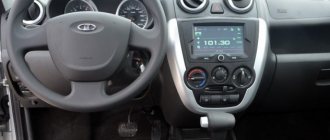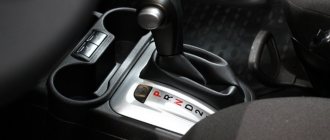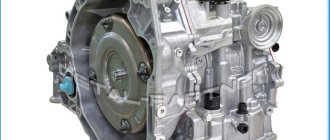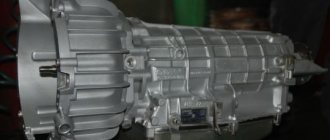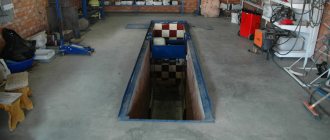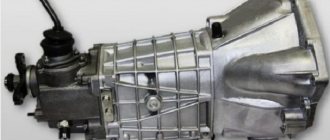The official manufacturer of the LADA Vesta car, AvtoVAZ, stated that already in the middle or end of 2022, the so-called “creeping mode” will be added to all models with AMT (automated transmission).
To implement such a mode, the manufacturer needs to flash the gearbox according to algorithm No. 1. Not long ago, a video appeared on the Internet, where it is clearly visible how a gearbox with a “creeping mode” works.
The operating algorithm of the updated gearbox will be extremely similar to the operating principle of an automatic transmission (automatic transmission). To start the mode, the driver must move the selector to position R or A. Then the brake pedal should be released and the car begins to roll at idle without consuming fuel.
Features of the robot's behavior after running in
As a rule, after running-in, the robot and the driver adapt to each other. The driver already automatically starts the engine from the neutral position of the lever and simultaneously presses the brakes. Gear changes have returned to normal and become shifts without interruption in the power flow or without "jerking".
Some reviews regarding the “behavior” of the robot after running-in recommend not to “fall” on the gas pedal when starting to move, trying to quickly gain speed to switch from the initial speed to the next one. This manipulation does not give the desired effect, however, the transition from second gear to third and subsequent transitions will be carried out much faster, unless, of course, you reduce engine speed by releasing the gas pedal.
In traffic, it is recommended to accelerate within the appropriate gear for the traffic flow, which makes driving as economical as possible. In this case, the gas pedal can be used to control the robot, indicating the engine speed at which switches it needs to make.
Features of the robot's future behavior
At the beginning of 2022, VAZ conducted surveys of users of cars with an AMT robot, probably noticing that many complaints were coming from car owners living in megacities, who are under the threat of regularly getting stuck in traffic jams, where the gearbox shows not entirely favorable “behavior.” And all this is due to the lack of the so-called “creeping mode”.
If we consider the conditions of being stuck in traffic jams, there are only two types of traffic jams:
- The first type is a standing traffic jam, where traffic occurs in the mode: drive 5-10 meters and stop. In this mode, judging by the reviews, the gearbox robot behaves quite well: the driver pressed the gas pedal - it moved smoothly and began to move, released the gas pedal - it stopped.
- The second type of traffic jam is when the flow of traffic moves at walking speed, where the notorious “creeping mode” is required. In this case, it is difficult for the driver to select the engine speed not in the first gear of the gearbox in order to move synchronously with the flow of cars in a traffic jam, since when adding gas, the gearbox takes a pause while the car is still rolling, and then begins sharp acceleration, while the driver releases the gas pedal and clutch turns off, etc. If you look from the side, the car moves jerkily.
According to yet unconfirmed information, it is precisely this problem of the AMT’s lack of a “creeping mode” that the VAZ developers plan to solve.
The AMT gearbox is not as popular as a manual or automatic transmission, although it combines both types of transmissions. What is it, what types of AMTs are there and how to ride them?
To transmit torque from the engine to the wheels, the car has a special device - a gearbox or transmission.
It can be mechanical, automatic, robotic or CVT.
The first three are stepped, that is, they have the usual first, second and other speeds, the last is stepless and works on a different principle.
The AMT gearbox is installed on many modern cars, including Russian-made cars.
Advanced models of such gearboxes are also found on sports cars.
There is an opinion that in the future AMT will become more widespread than automatic transmissions and will completely replace manual transmissions.
Which is better - robotic or automatic transmission?
Automatic or robot – the choice is not easy, but there is also a CVT. But the variator does not change speeds, since they change smoothly there. That is, it is not a gear change device. And a robot can be compared with an automatic one in terms of material parameters, acceleration dynamics, behavior in unfavorable conditions - when slipping, maneuvering on difficult road surfaces.
If we consider the comfort of the trip, the automatic transmission comes first. When it is more important to strive for profit, the robotic gearbox is in the lead, which has lower fuel and oil consumption. But automatic transmission is considered more predictable when driving. At first glance, when purchasing, it can be difficult to judge whether it is a robot or an automatic machine for the future owner. Both options do not have a clutch pedal, so you need to ask in advance which gearbox the selected model is equipped with.
Below you can see the comparison table between automatic transmission and robotic transmission.
| Automatic transmission | Robotic gearbox | |
| pros | Smooth acceleration and movement | The design is simpler than that of an automatic transmission |
| Easy machine control | Fuel economy and higher efficiency compared to automatic transmission | |
| No need to constantly replace the clutch | Repair and maintenance are cheaper than automatic transmissions | |
| Minuses | Efficiency lower than that of a robot | Jerky movement when starting and changing gears |
| Higher fuel consumption | Slower gear shifts | |
| High cost, including repairs | Unpredictability of behavior in difficult road conditions |
General information about the AMT robot
- The mechanical part is based on a five-speed modification of the VAZ model 2180 gearbox. Moreover, this gearbox is equipped with gear pairs with different output ratios for different Lada models. For example, the Vesta box has this output indicator of 3.9, when, as on Grants and Kalinas, it is 3.7.
- You cannot take an actuator (clutch pressing mechanism) and robot electronics and put it on a regular box of the same VAZ 2180 model so that the result is a robot. Although the reverse procedure of replacing a robot with a mechanical one can be carried out with overcoming some obstacles.
- It is believed that the actuator cannot be repaired or maintained, but this is not for our craftsmen. Cases of its failure, judging by the reviews, are very rare. Usually, they happened at the beginning of operation, while still under warranty. There were no cases of refusal to replace.
- The recommendation to change the oil in the AMT at a mileage of 120 thousand does not stand up to the criticism of mechanics; they recommend doing this at 75 thousand mileage.
- The adaptability or adaptability of the transmission to changing operating conditions of the engine and its load, the position of the gearbox engaged mode sensors (ECP), as well as the gas and brake pedals is ensured by reading the sensor information and analyzing this information. And based on the algorithms embedded in the robot’s program, a certain order of its actions is formed. In this case, the driver’s actions in various situations are taken into account, which are stored in the robot’s long-term memory. If we say all this in a simple and understandable language for everyone, then the AMT transmission adapts to the characteristics of the driving style of a particular driver and road conditions. Moreover, for this she usually needs a couple of tens of kilometers of driving in the city.
- The AMT robot is sensitive to engine load and quickly responds to the activation of maximum torque. At the same time, each subsequent gear can be engaged only when the engine speed drops below 2.5 thousand, and each subsequent one when the range from 4 to 4.5 thousand revolutions is reached. In addition, the degree of load perceived by the engine is taken into account. For example, on a slope, the AMT robot will switch to a lower gear if the load on the engine decreases, but will leave it in the most economical operating mode.
- AMT has its own peculiarities of operation in accordance with the established transmission modes. For example, in “M” mode, the gearbox switches faster compared to “A” mode.
Automatic AT or AMT: gearbox features
First of all, initially cars were equipped with only two types of gearboxes: traditional mechanics and hydromechanical automatic transmission (aka AT). However, later CVT variators appeared, as well as, relatively recently, robotic gearboxes (AMT and preselective manual transmissions).
If we talk about AT, this type of gearbox appeared a little later than manual transmission. For a long time, such a box remained the only type of automatic transmission, thanks to which, to this day, it continues to be one of the most common types of automatic transmission.
Now let's look at the classic automatic transmission and the relatively recently appeared robots such as AMT in more detail. Let's start with a traditional slot machine.
So, a hydromechanical automatic transmission is a complex and expensive device that combines elements of hydraulics, mechanics and electronics. An automatic transmission, unlike a CVT, is a step-type gearbox, that is, it has fixed gears.
Such a box did not receive the usual mechanical clutch, since the torque from the internal combustion engine is transmitted to the transmission through a special device (“donut” automatic transmission or torque converter).
ATF (automatic transmission oil) plays an important role in such machines. This liquid is not just a lubricant, but a working fluid. The torque converter converts torque and then transmits it to the gearbox through liquid.
The advantages of automatic transmission include fairly high comfort, smooth operation and reliability of the box. A working AT gearbox changes gears almost imperceptibly, operates quietly, without unnecessary noise or vibration.
At the same time, a classic automatic transmission (taking into account the peculiarities of its design and operation) requires a large amount of transmission oil and is sensitive to the quality of ATF and the condition of the fluid. Also, the unit is not designed for constant high loads, it is “afraid” of prolonged slipping, sudden starts, and driving at high speeds.
The presence of a torque converter also means that the efficiency of such a box is slightly lower compared to analogues (by 10-15%), which means increased fuel consumption and losses in acceleration dynamics.
The average service life of such automatic transmissions is 200-250 thousand km, but only subject to timely and high-quality maintenance, as well as compliance with a number of rules within the framework of the operation of vehicles equipped with an automatic transmission of this type. Let us also add that repairing automatic transmissions is also often difficult and expensive.
How does a manual transmission work?
Home » News
Published: 07/30/2017
All-round view – Problem: automatic transmission, robot or CVT?
Everyone knows that there are two main types of transmissions used in cars - manual and automatic transmissions.
However, there is a whole range of gearboxes that combine some of the operating principles of manual and automatic transmissions. One such transmission is the AMT, which is also an automated manual transmission.
This name is already quite widely known among motorists, but many still have the question: “What is this - an AMT gearbox?”
Not all motorists currently understand the difference between an automated transmission, which is AMT, and a pure “automatic”, which is familiar to the car owner. In this article we will look at the basic principles of operation of the AMT transmission, its differences from an automatic transmission (many car enthusiasts confuse them), as well as its pros and cons. Automatic transmission, robot or CVT. Which is better?
General characteristics and device of AMT
In fact, AMT has much more in common with a manual transmission than with an automatic transmission, as can be seen even from the decoding of the name (AMT - automated manual transmission). Essentially, this is the same mechanics, which is controlled using a special control unit. ROBOT BOX
How does the automatic transmission behave?
Many users note in their reviews that it makes no sense to get used to an outdated, albeit automatic, modification of the gearbox if it does not differ much in its operation from the AMT. But the Jatko box has a lot of advantages.
New Lada: Steering wheel vibrates at speeds over 100
Firstly, it shifts smoother, although slower than a modern AMT. Secondly, this is a completely imported unit. However, it is more expensive and requires an additional cooling system and original wheel drives during installation. For comparison: AMT consists of almost 80% domestic parts.
As a result, the price of the Lada Kalina automatic increases by at least 25 thousand rubles.
The main problem with the Jatco automatic transmission is fuel consumption. In the city in the off-season, taking into account traffic jams, slipping, and frequent stops, the automatic transmission will “eat up” from 11.5 to 12.5 liters per hundred kilometers, depending on driving style. Under similar conditions, a car with AMT consumes about 8.5 l/100 km.
Why did it happen that it has changed now?
Theoretical basis
The basis of the CVT gearbox is a 5-speed manual transmission from VAZ, but it is equipped with actuators from ZF from Germany. The Lada robot box was first released back in 2014 and installed on the Priora, then gradually moved to the Vesta, which needed 2-pedal versions, as if in the air - after all, the car’s competitors are foreign cars, while consumers do not like manual gear shifting .
The Lada robot box did not go well with its status.
However, Lada specialists replaced the firmware, conducted experiments with the clutch, then made a significant change in 2018, which was announced simultaneously with the release of the Vesta Cross sedan, but during a test in May these cars simply...disappeared.
For this reason, the wait dragged on until November.
Features of operation
In accordance with the reviews, a list of custom features of the AMT transmission has been compiled:
- Unlike an automatic transmission, AMT does not have such a mode as “parking” or “P”. Therefore, reviews recommend leaving the AMT in gear when parked, turning off the engine in mode “A” or “R”. And with the engine not running, move the lever to “N” mode, but even in this mode the gear will be engaged. When the ignition is turned on, the speed will automatically turn off. Therefore, you need to remember this feature of the AMT, and to prevent the car from rolling, in this case the car is fixed with the brake pedal. Moreover, the car will not start without pressing the brake pedal. Which some car enthusiasts point out as a disadvantage, and others as an advantage that increases the safety of starting the engine when the speed is accidentally turned on, for example, as with a manual transmission;
- Unlike simple mechanics and an automatic transmission, AMT will not move the car at idle speed, that is, driving at idle speed is impossible. To start moving smoothly, you need to add engine speed by pressing the gas. What is indicated as a disadvantage in reviews from residents of megacities, who often find themselves stuck in traffic jams. Therefore, for those who periodically encounter traffic jams, during short stops it is recommended to switch the lever to the “N” mode, because after a minute of parking with the brake pedal not pressed, the switch will disconnect the clutch by pressing the release lever, which can subsequently negatively affect the release bearing . However, some reviews provide examples of the opposite opinion, that this has absolutely no effect on the condition of the release bearing;
- There are many opinions in the reviews about braking using AMT. When braking the engine by resetting its speed, the AMT reacts quite sensitively in higher gears by switching to lower ones, but many recommend doing this in combination with the brake pedal depressed. Regarding smooth braking with the help of brakes, AMT “helps” to brake by switching lower gears. But during heavy braking, the AMT completely disengages the clutch. But in some reviews there are stories about some “sagging” of the brake pedal in these cases.
- after sharp braking, the clutch remains open until the engine speed is increased by the gas pedal;
- When you apply emergency braking using the brake pedal, the Brake Assist System (BAS) is activated and the clutch is instantly released.
Pros of robotic boxes
You can often come across such statements on the Internet - that robots have no advantages! And it can't be! This is not true, of course there are plenty of disadvantages (more on them below), now a little about the positive aspects (for starters, the single-disc version):
Price of the car and production. If you take a ROBOT with one disc, then this is most likely the cheapest automatic transmission, which is included in the price of the car. The difference with a CVT or automatic can reach up to 40,000 rubles.
Fuel consumption. Oddly enough, but with a manual transmission, it is lower than with a CVT or automatic transmission. In fact, this is a continuation of mechanics; there are simply no losses due to spinning up the torque converter.
There is a roll-up
This is important for many drivers who are switching from manuals. You can move the lever to position N yourself and roll down the hill, thereby saving fuel
And also modern ROBOTS can disengage the clutch themselves if you are rolling down a hill.
Now there is a separate option with two disks, there are even more advantages:
- There are no shocks when switching. Both when increasing and when decreasing (when you brake)
- Dynamic acceleration. In general, ROBOTS with two disks use much more engine efficiency (after all, there is no torque converter)
- Fuel economy. Here it is much larger than that of its brother
- Again there is a roll-up.
- Imitation of automatic or variator. For the driver, there are practically no differences in the switching and modes of this robotic box and opponents (everyone is familiar with the “D”, “N”, “R” and “P” modes).
- There is a “creeping mode” and no rollback. This is when you put your car in "D" and the car slowly creeps forward (even if you don't press the gas pedal).
Overall, the two-disc robotic box is very pleasant to use. However, there is always a “BUT” and there are many more disadvantages here.
Features of running in with a robot
In the reviews, especially from those who recently got behind the wheel of a Lada with an AMT robot, there is a lot of talk about how the robot is supposedly “dumb.” But there is a simple explanation for this supposedly “freezing” AMT. In the process of getting used to a new car, any driver, even impudent in other cases in relation to cars, does not “fall”, so to speak, with all his weight on the gas pedal.
He tries to drive the car like a pensioner, driving at low and medium speeds. Moreover, if, according to the AMT gear shift conditions, each subsequent gear is engaged when the engine reaches 4.5 thousand revolutions, then in this case this driver will not wait for the AMT to engage an upshift. This is the whole reason for the “stupidity” of AMT. In response to such statements, one can suggest that such drivers first “use” their brains, and then give the car gas. And immediately everything will fall into place.
Disadvantages of ROBOT
Again we will divide into two camps.
The simplest ROBOT, single-disk:
- Stupid, stupid and stupid again. I have not yet seen more than one mechanism that works adequately. Not on LADA, not on FIAT, not on TOYOTA. Its operation takes some getting used to; the jolts between gear changes are very noticeable. BUT what infuriates him the most is his thoughtfulness when you drive in a high gear and speed and brake sharply. And he remained in “fifth” position. Press on the gas pedal... until he realizes that he needs to lower the “speed” and drive normally, it may take 5 - 10 seconds. To be honest it's annoying...
- Frost and winter. My friend has a FIAT PANDA, it has a Dualogic robotic gearbox, it has a system with hydraulic drives and oil inside. So, it thickens from severe frost, and this is approximately - 20, -25 (which occurs in almost every region) and does not switch “ROBOT”, that is, they started the car and until it warms up, the gear will not engage. That is, it simply freezes. Of course, with a manual transmission with a fully electric system, this is not the case (and let’s say “VESTA” does not suffer from this). BUT the fact remains a fact.
- No crawling mode. YES, the single-disc version does not have it. That is, you have turned on the “D” or “A” mode, stand on a hill, release the brake, and the car rolls back! This is not an automatic machine, you need to take this into account
- Resource and repair. In general, a single-disk robot, not so expensive to repair! BUT, it will advance at 100,000 km. Why? I'll explain. The gearbox itself, “without an attachment”, is almost eternal, everyone has this). However, the breakdowns lie precisely in the “hinged” one. The first weak unit is the clutch - basket - release and flywheel. All this will require repairs closer to 100,000 km, it’s worth noting that it’s overly expensive, but you will have to pay 10–15,000 rubles for the original (“non-originals” are of course cheaper). Next, the actuator, if it is hydraulic, then it will require repairs and diagnostics, also closer to the “100”, and to do all this normally, you need good service and about 10 - 20,000 rubles. If you have completely electric “actuators” that are not maintained or repaired, then their service life can be 120 - 150,000 km, and replacement from 20 to 30,000 rubles (for example, on a LADA VESTA it costs from , and as they assure, it does not is being repaired... although our craftsmen will get here). It turns out that after 100,000 km, you will pay from 20 to 40,000 rubles to repair the robot (not a little).
Complex ROBOTS, two disks:
- Resource. Probably everyone remembers the first DSGs (the hype around them), when their clutches (and there are two of them) could fail after 40 - 60,000 km. Now, of course, all these bugs have been corrected (after all, the Germans are ahead of the rest here). BUT again, 120 - 150,000 km is almost the maximum limit, and only if you drive normally and do not tear your ROBO from its place.
- Repair and Price. It is difficult to repair, especially if you live somewhere in the outback (you need good diagnosticians). The price will also be far from 20 - 40 thousand, much more, if your “mechatronics” (the actuator of the DSG) breaks down, then the repair can cost a pretty penny (up to 100 thousand rubles), now, of course, there are analogues that cost less, but how long will they walk?
As you can see, everything is not very simple - a robotic box, this must be a conscious choice, you must clearly understand what can happen to it.
What changes have occurred
There are no changes in terms of hardware. However, the head of the entire project, V. Petunin, claims that cooperation with the clutch supply company Valeo is currently ongoing, the result of which should soon be the selection of the best composition for the friction lining. They are produced here, at the Valeo plant in Tolyatti, from here they are supplied with VAZ products.
Now the AMT Lada robot box is installed on the new Grant and West series with 1.8 liter engines. This gearbox is expected to appear on the XRay car soon.
However, the program with which control is carried out has been improved. Optimization of programs made it possible to reduce the time during which a gear switches from 1st to 2nd, as well as from 2nd to 3rd - by almost 30 percent (the synchronizer from Germany should withstand this), a special mode for traffic jams appeared, allowing the vehicle to move when the brake pedal is released. This ensures a smooth start.
Petunin spoke about common complaints from car owners who do not know how to correctly switch the robotic gearbox of the Lada Vesta, who stand in traffic jams for a long time or drive at maximum load in difficult situations. Many such motorists contacted the dealership, claiming that they had a transmission error light.
However, the instructions indicate that this indication is not critical; the temperature sensor is simply activated (the clutch becomes seriously heated during constant closure and slipping).
According to him, no standard situation on the road will lead to the car stopping. This is not bad, since, for example, many foreign automatic transmissions required constant throwing into the neutral position during stops or allowed the clutch to open during overheating, which is why they stood on the emergency warning light until it cooled down.
An algorithm has been added that allows you to accelerate on slippery surfaces in winter, but this requires the CVT transmission to switch to manual mode with the selection of 2nd gear (there is no separate button here). There is also a sports mode for the AMT Lada robot box, but the test failed because it has not yet been completed and is not available in existing cars.
Road characteristics
The missing sports mode of the auto transmission is not at all the main disadvantage of this gearbox. Taking the key to the Vesta Cross, which has a 1.8-liter engine installed, I initially noted that maneuvering in the parking lot was simplified, since there was no need to constantly “push” the gas pedal.
However, a very smooth start from a standstill causes vibration, which then manifests itself in congestion, for this reason it is preferable to slightly release the car from the front and then accelerate a little more vigorously. In addition, very low speeds are unpleasant for the 1.8 liter engine, it shakes.
https://youtube.com/watch?v=JnkrEGyM_ZY%3F
Alas, the longest traffic jam we managed to get into near Sochi lasted only twenty minutes, for this reason, checking the stability of the new car gearbox will be possible only in the pre-New Year's winter traffic jam in Moscow. However, it’s good that a sudden jerk from a stop is accompanied by greater gear shifting comfort for everyone in the cabin; from now on you won’t have to shake your head during each gear change; you’ll know how to correctly shift the Lada Vesta’s robotic gearbox.
Views: 1,817
Design and principle of operation
Many users do not fully understand the operating principle of the robotic box, considering it a complex mechanism. Structurally, the Lada 5 AMT gearbox is nothing more than a 5-speed manual gearbox, controlled by electronics.
So, let’s look at what 5 AMT is in detail. A detailed examination of the box produced by AvtoVAZ PJSC indicates that a standard mechanical-type automated transmission scheme is used using one disc in the friction clutch design.
The layout looks like this:
- Box clutch;
- Variable gearbox, mechanical type;
- Gearbox and clutch drives;
- Box control module.
A special device, mechatronics, is responsible for controlling the gears. Since it is a set of control elements in the form of sensors and electronics, the design does not provide mechanical connections for shifting gears.
It includes:
- Variable gearbox speed sensor on the input shaft;
- Gearbox mode control selector;
- An actuator that controls gear shifting and clutch release;
- Gearbox controller.
The gearbox operates in one of two modes: automatic and semi-automatic. Receiving information from sensors, in automatic mode the box changes gears without driver intervention. Gears are switched using software and signals from the control module. In manual mode, gears are changed by the driver using the shift lever. Move forward, upshift, move backward, downshift.
AMT for LADA Granta. Design Features
Cars of the LADA Granta family (sedan, liftback) have already received a proven AMT, which has been installed on LADA Priora since September 2014. It was developed by engineers of JSC AVTOVAZ together with specialists from the German concern ZF Friedrichshafen AG, which is the author and owner of many modern technologies and innovative solutions in the field of drive systems.
The design of the basic manual gearbox 2181 (modernization of gearbox 2180) was taken as a basis, on which the following were installed:
- 1. Electromechanical actuators that control gear shifting and clutch operation;
- 2. Input shaft speed sensor;
- 3. Controller.
2180 gearbox and electronic control unit
In addition, the following were completely removed from the gearbox:
- 1. Clutch drive;
- 2. Internal switching mechanism;
- 3. Cable gear shift drive.
Inside the car, the clutch pedal was removed, and instead of a mechanical (cable) gear shift drive, an electronically controlled selector was installed.
In addition to original design solutions, modern software was developed specifically for AMT, with the help of which the vehicle’s transmission is controlled.
All these changes, together with the electronic motor control controller and the on-board power supply network, made it possible to fully automate the processes of controlling the clutch and gear shifting, as well as ensuring high AMT functionality.
Advantages and disadvantages
Comparing the transmission with other representatives of automatic transmissions, we can highlight both positive and negative features of the box.
Advantages of the 5 AMT unit:
- Reduced fuel consumption, performance comparable to a 5 MT manual transmission;
- Low cost of spare parts and labor in case of gearbox repair;
- The design of the box allows you to tow the car using a cable or a rigid hitch;
- If the battery loses power, the box allows you to start the car from a pusher;
- The friction disc and gearbox lubricants are designed for the entire service life of the product;
- Protection of the box from incorrect switching, which avoids damage;
- The box has automatic and manual gear shifting;
- Smooth operation of the gas pedal facilitates the transition from gear to gear without jerks or failures;
- Switching occurs in a short period of time, within 120 ms;
- The presence of an automatic algorithm that allows you to start moving the machine while on an inclined surface.
Disadvantages present in the operation of the box:
- Since the gearbox is designed to use a clutch with one disc, this leads to loss of traction when shifting;
- It is not possible to use sports driving of the car, since the gearbox gives a smooth response when you press the gas pedal sharply;
- There is no way to forcefully equalize the speed of rotation of the gearbox shafts by manipulating the gas pedal;
- The absence of steering wheel switches, with which you can quickly change the algorithm of the gearbox.
Rules for using the AMT box on Lada
December 22, 2015 LadaOnline 68 340
The automated transmission (AMT-2182 or “robot”) is based on the manual transmission MKPP-2180, but control is carried out not by the driver, but by the system. It is worth considering that the operating instructions for automatic transmissions and automatic transmissions are different. AMT project manager Vladimir Petunin talks about how the AMT robot works on Lada cars.
AMT is installed on: Lada Granta, Kalina, Priora, Vesta and XRAY. All these cars have the same operating instructions for this transmission.
The robotic transmission has the following operating modes:
- Neutral position (N), when the brake pedal is released, the car can roll;
- Automatic (A), speed changes are carried out by the system. It is tuned for smoother and more comfortable shifts;
- Manual (M), switching is performed manually (up – “+” and down – “?”, without fixing the selector), which can be done more quickly, but within the functionality of the box. The system will change gear when the appropriate speed is reached. If you stop at a traffic light, AMT will automatically switch the speed down;
- Reverse (R).
The on-board computer on the instrument panel displays the following information:
- automatic or manual mode (AUTO or MANUAL);
- gear engaged;
- brake pedal pressure indicator.
To start an engine with an AMT gearbox, you should follow this order:
- Press the brake pedal;
- Move the gearshift lever to neutral;
- Turn the ignition key.
If one of the conditions is not met, the neutral indicator “N” or the “foot with brake” indicator will flash on the instrument cluster:
Correct operation of AMT Lada:
- Any changes in the position of the selector before driving should only be made with the brake pedal depressed;
- When stopping at an intersection or traffic light, you do not need to switch the selector to neutral;
- When parking the vehicle, turn off the engine with the gear engaged (A, M or R). In this case, it is not necessary to use the handbrake. The handbrake should be used when the selector is in neutral (N);
- The AMT system allows you to use the car at temperatures from -50°C to +50°C without any restrictions.
The car starts moving when the gas (accelerator) pedal is pressed. This closes the clutch. The “robot” does not have a creep mode, like an automatic transmission, because it does not have a torque converter.
When driving on steep slopes, the system will not switch the gearbox to 2nd speed to prevent engine stalls. Gear shifting will occur only if the maximum, critical speed is reached.
AMT is adaptive and has 26 shift maps that constantly interpolate with each other. That is, depending on the nature of the control (how the driver works with the gas pedal), the system selects the appropriate map and switches at the right moment. In any case, AMT will only engage a gear when the minimum possible speed for a given gear is reached.
When switching gears, you can feel some delay in the acceleration dynamics, which is a functional property of this transmission. The transmission is manual, so to change speed you need to disengage the clutch, change gear and engage the clutch. Only all this is done not by the driver, but by the car system.
The robotic box is protected against unintentional actions by the driver. For example, if, when moving forward in mode “A”, you turn on the reverse gear “R”, then nothing destructive will happen. The protection will also not change gears if the driver randomly moves the selector to different modes while driving.
All recommendations for operating AMT on Lada on video:
Another useful video tutorial:
Let us remind you that, in contrast to the cable gearbox (manual transmission 2181), on the AMT the howl is within normal limits. In this article we determine which transmission is better, automatic transmission or AMT. We leave reviews about the robotic box here.
Keywords: Lada Granta gearbox | gearbox Lada Kalina 2 | gearbox Lada Vesta | gearbox Lada Priora | gearbox lada xray | universal article
00Found an error? Select it and press Ctrl+Enter..
About the hum or howl of AMT (robot) on Lada cars Reviews of owners about the “robot” (AMT) on Lada cars, general assessment Production of the Lada Granta with a “robot” has started
Is it fair to install AMT robot in X-Ray
If you want to buy a car with a robotic gearbox, regardless of the make and model, but in the middle price category, you should pay attention to the operational features of the above-mentioned unit. A striking example would be the Lada X-Ray with the latest generation robot from similar automatic transmissions
The combination of technology with the simplicity of a car raises a lot of questions among the average consumer. If you understand them gradually, you can understand all the advantages, and come to terms with some of the disadvantages. Thus, a review of the X-ray fret will help you understand how effective the AMT robotic gearbox is, as well as in what driving modes it does not cause discomfort when switching.
In the video below you will find answers to the following questions:
- How to change gear if the car was turned off in neutral.
- How the X-Ray robot reacts to sharp gas when changing lanes.
- How the elongated main pair is displayed on the dynamics (how the gear ratios are selected, in comparison with Renault gearboxes).
- Can AMT be heard in the cabin (a huge difference from the Granta).
- Lever position when using manual shift mode.
Driving performance test
Considering that the car has a fairly powerful engine, it provides good dynamic performance in the city. In this case, even the AMT robot plays to the driver's advantage. When overtaking, the gear is pulled out for as long as possible, which allows you to safely complete the maneuver. When moving downhill, the “speed” always remains on, which is convenient for subsequent continuation of movement.
In the manual mode of using the box, completely different sensations are achieved, making it possible to understand when to release the gas to switch. In any mode of the box, the “prompt” on the dashboard continues to work.
Considering the high-torque power of the 1.8-liter engine, you can drive within one gear, which will be comfortable for overtaking and driving in traffic. A visual comparison in the realities of a busy road gives an overall impression of how the AMT robot on X-Ray, and the entire machine as a whole, works.
For a more detailed test of the “box – car” connection, see the video below. Let's drive around the city, check the operating modes of the gearbox, how much the 1.8 engine installed under the hood of the domestic crossover is enough for it. The author will share his emotions from using a car with a similar robot in city mode. What you don't like and what you have to put up with in everyday use.
Video test drive of the AMT box on X-Ray:
What cars can it be installed on?
The first car under the Lada Priora brand, equipped with AMT, was released in 2014; the installed gearbox was modified AMT-2182. After running in and finalizing the mechanisms and program elements, automatic manual transmissions began to be equipped with the Lada Granta, this happened in March 2015, and the Lada Vesta, in 2016. The Lada Kalina and Lada Xray cars were equipped with the same gearbox.
Later modifications of the gearboxes are structurally similar to the first gearbox released by the company. The difference lies in the improved program of the latest version, which was developed by the German company ZF Friedrichshafen AG. The principle is based on the use of a new transmission switching algorithm and improved functional logic. AMT has a number of operational features and is characterized as a simple, reliable, economical unit.
